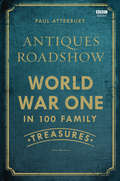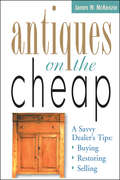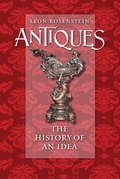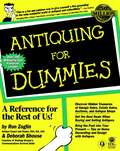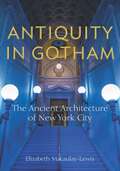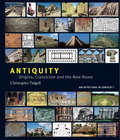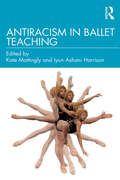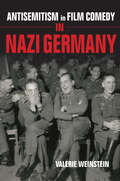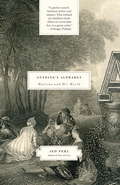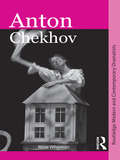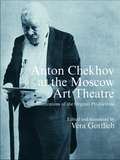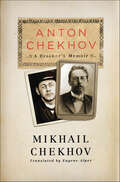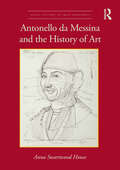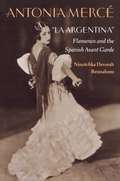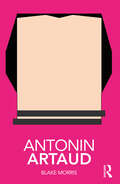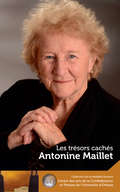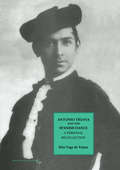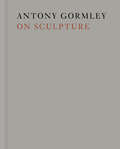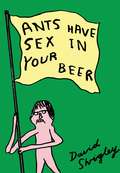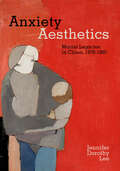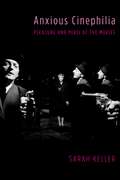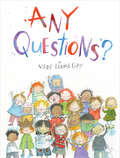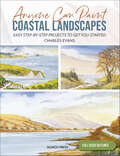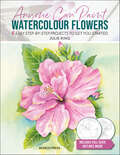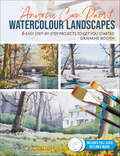- Table View
- List View
Antiques Roadshow: World War I in 100 Family Treasures
by Paul AtterburyTo mark the centenary of the start of World War I, the Antiques Roadshow team filmed a series of specials at the Somme, where the public brought in their family's war memorabilia and photographs. These 'antiques' weren't financially valuable, or in some cases even very beautiful, but the stories that came attached to these momentoes were priceless. Antiques Roadshow: World War I in 100 Family Treasures takes 100 of the most fascinating and moving stories and shows how they fit in to the wider history that was occuring around them. From Rifleman Frank Edwards, who led the 'big push' in September 1915 kicking a football in front of the troops (and survived to tell the tale) to the formidable Catherine Murray Roy, one of the first 50 nurses to be sent to the front lines in France. The story behind each object paints an intimate portrait of a long-lost relative, and quotes from the modern-day participants in the roadshow provide a moving link between the families then and now. Fully illustrated, and featuring all the stories from the show, this is a truly unique way of telling the story of those ordinary lives that were, by the onset of war in 1914, thrown into the most extraordinary of circumstances.
Antiques on the Cheap: A Savvy Dealer's Tips: Buying, Restoring, Selling
by James W. McKenzieGet the inside scoop on every aspect of antiquing - buying, cleaning, repairing, embellishing, refinishing, restoring, and selling. You'll find expert advice for getting great deals at auctions, flea markets, and shops, and you'll learn how to spot items that can be repaired to increase their value. Advice for selling antiques at flea markets, on consignment, and in shops is included.
Antiques: The History of an Idea
by Leon RosensteinThe notion of retrieving a bit of the past-by owning a material piece of it-has always appealed to humans. Often our most prized possessions are those that have had a long history before they came into our hands. Part of the pleasure we gain from the encounter with antiques stems from the palpable age and the assumed (sometimes imaginary) cultural resonances of the particular object. But precisely what is it about these objects that creates this attraction? What common characteristics do they share and why and how do these traits affect us as they do? In Antiques: The History of an Idea, Leon Rosenstein, a distinguished philosopher who has also been an antiques dealer for more than twenty years, offers a sweeping and lively account of the origin and development of the antique as both a cultural concept and an aesthetic category. He shows that the appeal of antiques is multifaceted: it concerns their value as commodities, their age and historical and cultural associations, their uniqueness, their sensuous and tactile values, their beauty. Exploring how the idea of antiques evolved over time, Rosenstein chronicles the history of antique collecting and connoisseurship. He describes changing conceptions of the past in different epochs as evidenced by preservations, restorations, and renascences; examines shifting attitudes toward foreign cultures as revealed in stylistic borrowings and the importation of artifacts; and investigates varying understandings of and meanings assigned to their traits and functions as historical objects.While relying on the past for his evidence, Rosenstein approaches antiques from an entirely original perspective, setting history within a philosophical framework. He begins by providing a working definition of antiques that distinguishes them from other artifacts in general and, more distinctly, both from works of fine art and from the collectible detritus of popular culture. He then establishes a novel set of criteria for determining when an artifact is an antique: ten traits that an object must possess in order to elicit the aesthetic response that is unique to antiques. Concluding with a provocative discussion of the relation between antiques and civilization, this engaging and thought-provoking book helps explain the enduring appeal of owning a piece of the past.
Antiquing For Dummies (For Dummies Ser.)
by Ron Zoglin Deborah Shouse“This is a fun and painless way to give yourself a firm grounding in the wide wonderful world of antiques and collectibles.” Kyle Husfloen, Managing Editor, Antique Trader Weekly and Antique Trader’s Antiques & Collectibles Price Guide Do you love to poke around estate sales and antique shops, but can’t tell the difference between Queen Anne and Queen Victoria furniture? Do you dream of owning that old Oriental rug or Meissen figurine — but worry that the dealer might gouge you on the price? Do you own pieces you think might be valuable — but don’t know where to go for a reliable appraisal? Relax. Antiquing For Dummies answers all your antiquing questions—and more. Whether you’re a beginner or you’ve already gotten your feet wet, this fun, friendly guide will give you the savvy you need to cruise, schmooze, bargain for, and care for antiques with confidence. In no time you’ll be able to: Tell the difference between real antiques and stuff that’s just old Develop an antique hunt plan of attack Select antiques based on the 5 key points of the “RADAR Test” Discover hidden treasures at garages, estate sales, auctions, and shops Get the best deals when buying and selling antiques Decorate with antique glass and porcelain from around the world Clean and care for your precious finds Work an auction—real-time and online Writing with humor and common sense, Ron Zoglin and Deborah Shouse demystify the highfaluting terminology of the antique world. And step-by-step they walk you through all the antiquing essential, including: Different furniture styles and periods of furniture and how to distinguish them Dovetails, nails, and other construction elements that offer clues to a piece’s age Where to go for the best antique bargains — includes tips on how to bid at auctions in person or online All about antique glass, ceramics and silver Integrating antiques into your life at home and at the office Antiquing For Dummies gets you up and running with what you need to know to find, research, and negotiate prices like a pro.
Antiquity in Gotham: The Ancient Architecture of New York City
by Elizabeth Macaulay-LewisThe first detailed study of “Neo-Antique” architecture applies an archaeological lens to the study of New York City’s structuresSince the city’s inception, New Yorkers have deliberately and purposefully engaged with ancient architecture to design and erect many of its most iconic buildings and monuments, including Grand Central Terminal and the Soldiers’ and Sailors’ Memorial Arch in Brooklyn, as well as forgotten gems such as Snug Harbor on Staten Island and the Gould Memorial Library in the Bronx. Antiquity in Gotham interprets the various ways ancient architecture was re-conceived in New York City from the eighteenth century to the early twenty-first century. Contextualizing New York’s Neo-Antique architecture within larger American architectural trends, author Elizabeth Macaulay-Lewis applies an archaeological lens to the study of the New York buildings that incorporated these various models in their design, bringing together these diverse sources of inspiration into a single continuum. Antiquity in Gotham explores how ancient architecture communicated the political ideals of the new republic through the adaptation of Greek and Roman architecture, how Egyptian temples conveyed the city’s new technological achievements, and how the ancient Near East served many artistic masters, decorating the interiors of glitzy Gilded Age restaurants and the tops of skyscrapers. Rather than classifying neo-classical (and Greek Revival), Egyptianizing, and architecture inspired by the ancient Near East into distinct categories, Macaulay-Lewis applies the Neo-Antique framework that considers the similarities and differences—intellectually, conceptually, and chronologically—among the reception of these different architectural traditions. This fundamentally interdisciplinary project draws upon all available evidence and archival materials—such as the letters and memos of architects and their patrons, and the commentary in contemporary newspapers and magazines—to provide a lively multi-dimensional analysis that examines not only the city’s ancient buildings and rooms themselves but also how New Yorkers envisaged them, lived in them, talked about them, and reacted to them. Antiquity offered New Yorkers architecture with flexible aesthetic, functional, cultural, and intellectual resonances—whether it be the democratic ideals of Periclean Athens, the technological might of Pharaonic Egypt, or the majesty of Imperial Rome. The result of these dialogues with ancient architectural forms was the creation of innovative architecture that has defined New York City’s skyline throughout its history.
Antiquity: Origins, Classicism and The New Rome
by Christopher TadgellThe first in a new series of five books describing and illustrating the seminal architectural traditions of the world, Antiquity traces architectural history from its very beginnings until the time when the traditions that shape today’s environments began to flourish. More than a catalogue of buildings, in this work Tadgell provides their political, technological, social and cultural contexts and explores architecture, not only as the development of form and space but as an expression of the civilization within which it evolves. The buildings are analyzed and illustrated with over 1200 colour photographs and 400 drawings while the societies that produced them are brought to life through a broad selection of their artefacts.
Antiracism in Ballet Teaching
by Kate Mattingly Iyun Ashani HarrisonThis new collection of essays and interviews assembles research on teaching methods, choreographic processes, and archival material that challenges systemic exclusions and provides practitioners with accessible steps to creating more equitable teaching environments, curricula, classes, and artistic settings. Antiracism in Ballet Teaching gives readers a wealth of options for addressing and dismantling racialized biases in ballet teaching, as well as in approaches to leadership and choreography. Chapters are organized into three sections - Identities, Pedagogies, and Futurities - that illuminate evolving approaches to choreographing and teaching ballet, shine light on artists, teachers, and dancers who are lesser known/less visible in a racialized canon, and amplify the importance of holistic practices that integrate ballet history with technique and choreography. Chapter authors include award-winning studio owners, as well as acclaimed choreographers, educators, and scholars. The collection ends with interviews featuring ballet company directors (Robert Garland and Alonzo King), world-renowned scholars (Clare Croft, Thomas F. DeFrantz, Brenda Dixon Gottschild), sought-after choreographers (Jennifer Archibald and Claudia Schreier), and beloved educators (Keesha Beckford, Tai Jimenez, and Endalyn Taylor). This is an essential resource for anyone teaching or learning to teach ballet in the Twenty First Century.
Antisemitism in Film Comedy in Nazi Germany
by Valerie WeinsteinToday many Germans remain nostalgic about "classic" film comedies created during the 1930s, viewing them as a part of the Nazi era that was not tainted with antisemitism. In Antisemitism in Film Comedy in Nazi Germany, Valerie Weinstein scrutinizes these comic productions and demonstrates that film comedy, despite its innocent appearance, was a critical component in the effort to separate "Jews" from "Germans" physically, economically, and artistically. Weinstein highlights how the German propaganda ministry used directives, pre- and post-production censorship, financial incentives, and influence over film critics and their judgments to replace Jewish "wit" with a slower, simpler, and more direct German "humor" that affirmed values that the Nazis associated with the Aryan race. Through contextualized analyses of historical documents and individual films, Weinstein reveals how humor, coded hints and traces, absences, and substitutes in Third Reich film comedy helped spectators imagine an abstract "Jewishness" and a "German" identity and community free from the former. As resurgent populist nationalism and overt racism continue to grow around the world today, Weinstein’s study helps us rethink racism and prejudice in popular culture and reconceptualize the relationships between film humor, national identity, and race.
Antoine's Alphabet
by Jed PerlAntoine Watteau, one of the most mysterious painters who ever lived, is the inspiration for this delightful investigation of the tangled relationship between art and life. Weaving together historical fact and personal reflections, the influential art critic Jed Perl reconstructs the amazing story of this pioneering bohemian artist who, although he died in 1721, when he was only thirty-six, has influenced innumerable painters and writers in the centuries since—and whose work continues to deepen our understanding of the place that love, friendship, and pleasure have in our daily lives. Perl creates an astonishing experience by gathering his reflections on this “master of silken surfaces and elusive emotions” in the form of an alphabet—a fairy tale for adults—giving us a new way to think about art. This brilliant collage of a book is a hunt for the treasure of Watteau’s life and vision that encompasses the glamour and intrigue of eighteenth-century Paris, the riotous history of Harlequin and Pierrot, and the work of such modern giants as Cézanne, Picasso, and Samuel Beckett. By turns somber and beguiling, analytical and impressionistic,Antoine’s Alphabetreaffirms the contemporary relevance of the greatest of all painters of young love and imperishable dreams. It is a book to savor, to share, to return to again and again.
Anton Chekhov (Routledge Modern and Contemporary Dramatists)
by Rose WhymanAnton Chekhov offers a critical introduction to the plays and productions of this canonical playwright, examining the genius of Chekhov's writing, theatrical representation and dramatic philosophy. Emphasising Chekhov’s continued relevance and his mastery of the tragicomic, Rose Whyman provides an insightful assessment of his life and work. All of Chekhov’s major dramas are analysed, in addition to his vaudevilles, one-act plays and stories. The works are studied in relation to traditional criticism and more recent theoretical and cultural standpoints, including cultural materialism, philosophy and gender studies. Analysis of key historical and recent productions, display the development of the drama, as well as the playwright’s continued appeal. Anton Chekhov provides readers with an accessible comparative study of the relationship between Chekhov's life, work and ideological thought.
Anton Chekhov at the Moscow Art Theatre: Illustrations of the Original Productions
by Vera GottliebThe Moscow Art Theatre is still recognized as having more impact on modern theatre than any company in the world. This lavishly illustrated and beautifully produced facsimile edition of a Russian journal from 1914 documents, photographically, the premieres of all of Anton Chekhov's plays produced by the Moscow Art Theatre, including:*The Seagull, *Three Sisters*Uncle Vanya*Cherry Orchard*Ivanov.Edited by renowned theatre historian Vera Gottlieb, the volume also reproduces - for the first time in an English translation - introductions by Stanislavsky's collaborators Nemirovich-Danchenko and Efros. With 175 unique photographs, this is a significant contribution to our understanding of the origins of today's theatre.
Anton Chekhov: A Brother's Memoir
by Mikhail ChekhovIn a style reminiscent of Anton Chekhov himself--realistic, intimate, and dynamic--Mikhail Chekhov shares unparalleled memories and insights, transporting readers into the world of the Chekhov family. He visits the places where his brother lived and worked and introduces the people he knew and loved, Leo Tolstoy and Piotr Tchaikovsky among them. As a unique eyewitness to the beloved writer's formative years and his artistic maturity, Mikhail Chekhov shows here first-hand the events that inspired the plots for The Seagull, The Black Monk, and The Steppe, among other enduring works. Captivating, surprising, and a joy to read, this memoir reveals the remarkable life of one the most masterful storytellers of our time.
Antonello da Messina and the History of Art (Visual Culture in Early Modernity)
by Anna Swartwood HouseThis book argues that painter Antonello da Messina (c. 1430–1479) is a formative cross-cultural figure in the practice of art history itself.Featuring new interpretations of some of his best-known works, Anna Swartwood House shows how the uncertainties surrounding the painter have made him a uniquely pliable figure, easily inserted into different narratives of contact, cultural translation, and exchange. Using a wide range of materials including archival documents, biographies, civic histories, collectors’ notes, and popular literature, House traces the fortunes of an artist continually defined by place.The book will be of interest to scholars working in art history, Renaissance studies, early modern history, and historiography.
Antonia Mercé, “LaArgentina”: Flamenco and the Spanish Avant Garde
by Ninotchka BennahumAntonia Mercé, stage-named La Argentina, was the most celebrated Spanish dancer of the early 20th century. Her intensive musical and theatrical collaborations with members of the Spanish vanguard -- Manuel de Falla, Frederico García Lorca, Enrique Granados, Néstor de la Torre, Joaquín Nín, and with renowned Andalusian Gypsy dancers -- reflect her importance as an artistic symbol for contemporary Spain and its cultural history. When she died in 1936, newspapers around the world mourned the passing of the "Flamenco Pavlova."
Antonin Artaud (Routledge Performance Practitioners)
by Blake MorrisRoutledge Performance Practitioners is a series of introductory guides to the key theatre-makers of the last century. Each volume explains the background to and the work of one of the major influences on twentieth- and twenty-first-century performance. Antonin Artaud was an active theatre-maker and theorist whose ideas reshaped contemporary approaches to performance. This is the first book to combine an overview of Artaud’s life with a focus on his work as an actor and director; an analysis of his key theories, including the Theatre of Cruelty and the double; a consideration of his work as a director at the Théâtre Alfred Jarry and his production of Strindberg’s A Dream Play; and a series of practical exercises to develop an approach to theatre based on Artaud’s key ideas. As a first step towards critical understanding and as an initial exploration before going on to further, primary research, Routledge Performance Practitioners are unbeatable value for today’s student.
Antonine Maillet: Les trésors cachés - Our Hidden Treasures (The Symons Medal Series/Collection de la Médaille Symons)
by Antonine MailletA veritable artist, Maillet becomes a “creator of sounds, of colours, of forms and words.” As she speaks, she paints a vast landscape of mountains and oceans, history and story, using the tools on her palette: blending the colours of myths and those of contemporary issues, creating an epic poem in a profoundly personal voice. This country she portrays is both young and old, speaks two languages, has a rich subconscious, and aspirations. She ends her lecture by re-telling a story originally written by Rabelais— which, incidentally, was penned the same year as the discovery of America. The grande dame of storytelling uses her art to make an appeal for solidarity, in favour of the protection of cultures and the preservation of languages. Will her country, she asks, the one made “of many faces” and paradoxes, “be able to give nations of diverse origins their rightful place?” Renowned, notably, for her iconic play La Sagouine, Antonine Maillet received the prestigious Prix Goncourt for her novel Pélagie-la-Charette, thereby becoming the first non-European laureate of the most prestigious award in France. Since then, she has published over twenty novels and many plays, and also translated several celebrated authors such as Shakespeare. She is the recipient of numerous literary awards, including the Governor General Literary Award, the Royal Society of Canada’s Lorne Pierce Medal, and the Prix Goncourt. This book is bilingual.
Antonio Triana and the Spanish Dance: A Personal Recollection (Choreography and Dance Studies Series #Vol. 6)
by Rita Vega de TrianaThis book also traces the evolution of the Spanish Dance technique, marked as it is by a turbulent history. Antonio Triana was a dancer of mature artistry, dignity and power. His physical and technical achievements went beyond what is generally known about Spanish Dance. His dance presented the essence of the Spanish character and, in his choreography, he used his traditional background for his brilliant inspirations. He partnered the legendary La Argentinita, Pilar Lopez and Carmen Amaya with spirit and gallantry. Over the years he developed a very distinct method of teaching and he became one of the foremost Spanish Flamenco dancers and teachers of his time. Rita Vega de Triana formed the Triana Ballet Español with her late husband. She currently teaches Hispanic dance and related subjects at the University of Texas at El Paso and directs her own school as well as performing around the United States as a guest artist and choreographer.
Antony Gormley on Sculpture
by Antony GormleyOne of the most exciting sculptors of our time, Antony Gormley is the creator of breathtaking public installations. Even casual fans will recognize Event Horizon, a collection of thirty-one life-size casts of the artist’s body that have been installed atop buildings in places like London’s South Bank and New York’s Madison Square, and Field, formed by tens of thousands of standing clay figurines overflowing across a room’s floor. Projects like these demonstrate Gormley’s ongoing interest in exploring the human form and its relationships with the rest of the material world, and in Antony Gormley on Sculpture, he shares valuable insight into his work and the history of sculpture itself. Combining commentary on his own works with discussions of other artists and the Eastern religious traditions that have inspired him, Gormley offers wisdom on topics such as the body in space, how to approach an environment when conceiving an installation, bringing mindfulness and internal balance to sculpture, and much more. Lavishly illustrated, this book will be of interest to not only art lovers, curators, and critics, but also artists and art students. Dynamic and thought-provoking, Antony Gormley on Sculpture is essential reading for anyone fascinated by sculpture and its long and complex history as a medium.
Ants Have Sex in Your Beer
by David ShrigleyThis all-new collection of David Shrigley's addictively strange and entertaining work reveals fresh, unsettling truths and anxious amusements in a format that welcomes the uninitiated and rewards the faithful.
Anxiety Aesthetics: Maoist Legacies in China, 1978–1985
by Jennifer Dorothy LeeAnxiety Aesthetics is the first book to consider a prehistory of contemporaneity in China through the emergent creative practices in the aftermath of the Mao era. Arguing that socialist residues underwrite contemporary Chinese art, complicating its theorization through Maoism, Jennifer Dorothy Lee traces a selection of historical events and controversies in late 1970s and early 1980s Beijing. Lee offers a fresh critical frame for doing symptomatic readings of protest ephemera and artistic interventions in the Beijing Spring social movement of 1978–80, while exploring the rhetoric of heated debates waged in institutional contexts prior to the '85 New Wave. Lee demonstrates how socialist aesthetic theories and structures continued to shape young artists' engagement with both space and selfhood and occupied the minds of figures looking to reform the nation. In magnifying this fleeting moment, Lee provides a new historical foundation for the unprecedented global exposure of contemporary Chinese art today.
Anxious Cinephilia: Pleasure and Peril at the Movies (Film and Culture Series)
by Sarah KellerThe advent of new screening practices and viewing habits in the twenty-first century has spurred a public debate over what it means to be a “cinephile.” In Anxious Cinephilia, Sarah Keller places these competing visions in historical and theoretical perspective, tracing how the love of movies intertwines with anxieties over the content and impermanence of cinematic images.Keller reframes the history of cinephilia from the earliest days of film through the French New Wave and into the streaming era, arguing that love and fear have shaped the cinematic experience from its earliest days. This anxious love for the cinema marks both institutional practices and personal experiences, from the curation of the moviegoing experience to the creation of community and identity through film festivals to posting on social media. Through a detailed analysis of films and film history, Keller examines how changes in cinema practice and spectatorship create anxiety even as they inspire nostalgia. Anxious Cinephilia offers a new theoretical approach to the relationship between spectator and cinema and reimagines the concept of cinephilia to embrace its diverse forms and its uncertain future.
Any Questions?
by Marie-Louise GayWhere does the story start? Marie-Louise Gay explains the creative process with typical fun and whimsy. Many children want to know where stories come from and how a book is made. Marie-Louise Gay’s new picture book provides them with some delightfully inspiring answers in a fictional encounter between an author and some very curious children, who collaborate on writing and illustrating a story. Marie-Louise has scribbled, sketched, scrawled, doodled, penciled, collaged and painted the words and pictures of a story-within-a-story that show how brilliant ideas creep up on you when you least expect it and how words sometimes float out of nowhere asking to be written. Any Questions? presents a world inhabited by lost polar bears, soaring pterodactyls, talking trees and spotted snails, with cameo appearances by some of Marie-Louise’s favorite characters — a world where kids can become part of the story and let their imaginations run wild… and just maybe they will be inspired to create stories of their own. At the end of the book, Marie-Louise provides answers to many of the questions children have asked her over the years, such as “Are you Stella?” “How did you learn to draw?” “Can your cat fly?” “How many books do you make in one day?” Correlates to the Common Core State Standards in English Language Arts: CCSS.ELA-LITERACY.RL.2.6 Acknowledge differences in the points of view of characters, including by speaking in a different voice for each character when reading dialogue aloud. CCSS.ELA-LITERACY.RL.3.1 Ask and answer questions to demonstrate understanding of a text, referring explicitly to the text as the basis for the answers.
Anyone Can Paint Coastal Landscapes
by Charles EvansUse the full-size traceable outlines and the clear step-by-step instructions to create 6 dynamic coastal landscape paintings, and learn the key skills you need to become an accomplished artist.
Anyone Can Paint Watercolour Flowers: 6 Easy Step-by-Step Projects to Get You Started
by Julie KingThis inspiring book has been reimagined as part of the accessible Anyone Can Paint series. Whether you are a beginner or a more experienced artist you will be amazed at how quickly you can produce beautiful paintings following the clear, straightforward written and visual steps. The outlines for each of the six projects appear at the end of the book for you to trace, transfer and customize so you can start to paint impressive floral compositions straight away.Written by professional artist and tutor Julie King, this guide features a short but inclusive ‘what you need’ section, enabling you to gather together the paints, brushes, and basic equipment required before you start painting. Additionally, the book provides some brief guidance on general techniques, such as how to hold the brush, how to add water to your paint, and how to mix your colours to achieve the perfect petal hue.The six stunning step-by-step projects that follow build in difficulty as you work through the book, introducing new techniques as they are used and incorporating numerous handy hints and tips from the author to help you progress on your painting journey.Previously published as The Paint Pad Artist: Watercolour Flowers (9781782216261).
Anyone Can Paint Watercolour Landscapes
by Grahame BoothThis inspiring book has been reimagined as part of the accessible Anyone Can Paint series. Whether you are a beginner or a more experienced artist you will be amazed at how quickly you can produce beautiful paintings following the clear, straightforward written and visual steps. The outlines for each of the six projects appear at the end of the book for you to trace, transfer and customize so you can start to paint impressive landscapes straight away.Written by professional artist and tutor Grahame Booth, this guide features a short but inclusive ‘what you need’ section, enabling you to gather together the paints, brushes and basic equipment required before you start painting, and some brief guidance on general techniques such as how to hold the brush, how to add water to your paint and how to mix colour, plus how to frame and display your work.The six stunning step-by-step projects that follow build in difficulty as you work through the book, introducing new techniques as they are used and incorporating numerous handy hints and tips from the author to help you progress on your painting journey.Previously published as The Paint Pad Artist: Watercolour Landscapes (9781782216278).
